[English] 日本語
 Yorodumi
Yorodumi- PDB-6phk: Crystal structure of glucagon analog with mono-stereoinversion at... -
+ Open data
Open data
- Basic information
Basic information
| Entry | Database: PDB / ID: 6phk | ||||||
|---|---|---|---|---|---|---|---|
| Title | Crystal structure of glucagon analog with mono-stereoinversion at position 21 (D-Asp21) in space group I41 at 1.18 A resolution | ||||||
 Components Components | Glucagon | ||||||
 Keywords Keywords | HORMONE / glucagon / GPCR ligand / peptide hormone | ||||||
| Function / homology |  Function and homology information Function and homology informationglucagon receptor binding / : / negative regulation of execution phase of apoptosis / feeding behavior / positive regulation of calcium ion import / Synthesis, secretion, and deacylation of Ghrelin / positive regulation of insulin secretion involved in cellular response to glucose stimulus / positive regulation of gluconeogenesis / cellular response to glucagon stimulus / regulation of insulin secretion ...glucagon receptor binding / : / negative regulation of execution phase of apoptosis / feeding behavior / positive regulation of calcium ion import / Synthesis, secretion, and deacylation of Ghrelin / positive regulation of insulin secretion involved in cellular response to glucose stimulus / positive regulation of gluconeogenesis / cellular response to glucagon stimulus / regulation of insulin secretion / response to activity / gluconeogenesis / hormone activity / adenylate cyclase-modulating G protein-coupled receptor signaling pathway / adenylate cyclase-activating G protein-coupled receptor signaling pathway / Glucagon signaling in metabolic regulation / Synthesis, secretion, and inactivation of Glucagon-like Peptide-1 (GLP-1) / Glucagon-type ligand receptors / Glucagon-like Peptide-1 (GLP1) regulates insulin secretion / glucose homeostasis / secretory granule lumen / G alpha (s) signalling events / G alpha (q) signalling events / positive regulation of ERK1 and ERK2 cascade / G protein-coupled receptor signaling pathway / receptor ligand activity / endoplasmic reticulum lumen / signaling receptor binding / negative regulation of apoptotic process / extracellular space / extracellular region / identical protein binding / plasma membrane Similarity search - Function | ||||||
| Biological species |  Homo sapiens (human) Homo sapiens (human) | ||||||
| Method |  X-RAY DIFFRACTION / X-RAY DIFFRACTION /  SYNCHROTRON / SYNCHROTRON /  MOLECULAR REPLACEMENT / Resolution: 1.18 Å MOLECULAR REPLACEMENT / Resolution: 1.18 Å | ||||||
 Authors Authors | Mroz, P.A. / Gonzalez-Gutierrez, G. / DiMarchi, R.D. | ||||||
| Funding support |  United States, 1items United States, 1items
| ||||||
 Citation Citation |  Journal: To Be Published Journal: To Be PublishedTitle: High resolution X-ray structure of glucagon and selected stereo-inversed analogs in novel crystallographic packing arrangement. Authors: Mroz, P.A. / Gonzalez-Gutierrez, G. / DiMarchi, R.D. #1: Journal: Acta Crystallogr D Biol Crystallogr / Year: 2010 Title: PHENIX: a comprehensive Python-based system for macromolecular structure solution. Authors: Paul D Adams / Pavel V Afonine / Gábor Bunkóczi / Vincent B Chen / Ian W Davis / Nathaniel Echols / Jeffrey J Headd / Li-Wei Hung / Gary J Kapral / Ralf W Grosse-Kunstleve / Airlie J McCoy ...Authors: Paul D Adams / Pavel V Afonine / Gábor Bunkóczi / Vincent B Chen / Ian W Davis / Nathaniel Echols / Jeffrey J Headd / Li-Wei Hung / Gary J Kapral / Ralf W Grosse-Kunstleve / Airlie J McCoy / Nigel W Moriarty / Robert Oeffner / Randy J Read / David C Richardson / Jane S Richardson / Thomas C Terwilliger / Peter H Zwart /  Abstract: Macromolecular X-ray crystallography is routinely applied to understand biological processes at a molecular level. However, significant time and effort are still required to solve and complete many ...Macromolecular X-ray crystallography is routinely applied to understand biological processes at a molecular level. However, significant time and effort are still required to solve and complete many of these structures because of the need for manual interpretation of complex numerical data using many software packages and the repeated use of interactive three-dimensional graphics. PHENIX has been developed to provide a comprehensive system for macromolecular crystallographic structure solution with an emphasis on the automation of all procedures. This has relied on the development of algorithms that minimize or eliminate subjective input, the development of algorithms that automate procedures that are traditionally performed by hand and, finally, the development of a framework that allows a tight integration between the algorithms. | ||||||
| History |
|
- Structure visualization
Structure visualization
| Structure viewer | Molecule:  Molmil Molmil Jmol/JSmol Jmol/JSmol |
|---|
- Downloads & links
Downloads & links
- Download
Download
| PDBx/mmCIF format |  6phk.cif.gz 6phk.cif.gz | 32.3 KB | Display |  PDBx/mmCIF format PDBx/mmCIF format |
|---|---|---|---|---|
| PDB format |  pdb6phk.ent.gz pdb6phk.ent.gz | 21.1 KB | Display |  PDB format PDB format |
| PDBx/mmJSON format |  6phk.json.gz 6phk.json.gz | Tree view |  PDBx/mmJSON format PDBx/mmJSON format | |
| Others |  Other downloads Other downloads |
-Validation report
| Summary document |  6phk_validation.pdf.gz 6phk_validation.pdf.gz | 403.2 KB | Display |  wwPDB validaton report wwPDB validaton report |
|---|---|---|---|---|
| Full document |  6phk_full_validation.pdf.gz 6phk_full_validation.pdf.gz | 403.1 KB | Display | |
| Data in XML |  6phk_validation.xml.gz 6phk_validation.xml.gz | 3.6 KB | Display | |
| Data in CIF |  6phk_validation.cif.gz 6phk_validation.cif.gz | 4.2 KB | Display | |
| Arichive directory |  https://data.pdbj.org/pub/pdb/validation_reports/ph/6phk https://data.pdbj.org/pub/pdb/validation_reports/ph/6phk ftp://data.pdbj.org/pub/pdb/validation_reports/ph/6phk ftp://data.pdbj.org/pub/pdb/validation_reports/ph/6phk | HTTPS FTP |
-Related structure data
| Related structure data |  6phiC  6phjC  6phlC 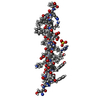 6phmC 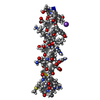 6phnC  6phoSC 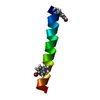 6phpC 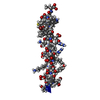 6phqC S: Starting model for refinement C: citing same article ( |
|---|---|
| Similar structure data |
- Links
Links
- Assembly
Assembly
| Deposited unit | 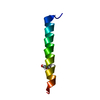
| ||||||||
|---|---|---|---|---|---|---|---|---|---|
| 1 |
| ||||||||
| Unit cell |
|
- Components
Components
| #1: Protein/peptide | Mass: 3486.781 Da / Num. of mol.: 1 / Fragment: UNP residues 53-81 / Mutation: D21D-Asp / Source method: obtained synthetically / Source: (synth.)  Homo sapiens (human) / References: UniProt: P01275 Homo sapiens (human) / References: UniProt: P01275 |
|---|---|
| #2: Water | ChemComp-HOH / |
| Has ligand of interest | Y |
| Has protein modification | N |
-Experimental details
-Experiment
| Experiment | Method:  X-RAY DIFFRACTION / Number of used crystals: 1 X-RAY DIFFRACTION / Number of used crystals: 1 |
|---|
- Sample preparation
Sample preparation
| Crystal | Density Matthews: 1.79 Å3/Da / Density % sol: 31.38 % |
|---|---|
| Crystal grow | Temperature: 293 K / Method: vapor diffusion, hanging drop / pH: 6 Details: 0.2 M lithium sulfate, 20% butanediol, 0.1 M MES, pH 6 |
-Data collection
| Diffraction | Mean temperature: 100 K / Serial crystal experiment: N |
|---|---|
| Diffraction source | Source:  SYNCHROTRON / Site: SYNCHROTRON / Site:  ALS ALS  / Beamline: 4.2.2 / Wavelength: 1.00003 Å / Beamline: 4.2.2 / Wavelength: 1.00003 Å |
| Detector | Type: RDI CMOS_8M / Detector: CMOS / Date: Sep 20, 2017 |
| Radiation | Monochromator: double crystal Si(111) / Protocol: SINGLE WAVELENGTH / Monochromatic (M) / Laue (L): M / Scattering type: x-ray |
| Radiation wavelength | Wavelength: 1.00003 Å / Relative weight: 1 |
| Reflection | Resolution: 1.18→29.93 Å / Num. obs: 8158 / % possible obs: 99.5 % / Redundancy: 11.3 % / CC1/2: 0.999 / Rpim(I) all: 0.022 / Rrim(I) all: 0.074 / Rsym value: 0.07 / Net I/σ(I): 19.2 |
| Reflection shell | Resolution: 1.18→1.23 Å / Mean I/σ(I) obs: 8.5 / Num. unique obs: 882 / CC1/2: 0.997 / Rpim(I) all: 0.075 / Rrim(I) all: 0.181 / Rsym value: 0.163 / % possible all: 98.6 |
- Processing
Processing
| Software |
| |||||||||||||||||||||||||||||||||||||||||||||||||
|---|---|---|---|---|---|---|---|---|---|---|---|---|---|---|---|---|---|---|---|---|---|---|---|---|---|---|---|---|---|---|---|---|---|---|---|---|---|---|---|---|---|---|---|---|---|---|---|---|---|---|
| Refinement | Method to determine structure:  MOLECULAR REPLACEMENT MOLECULAR REPLACEMENTStarting model: PDB entry 6PHO Resolution: 1.18→29.93 Å / SU ML: 0.07 / Cross valid method: FREE R-VALUE / σ(F): 1.34 / Phase error: 17.32
| |||||||||||||||||||||||||||||||||||||||||||||||||
| Solvent computation | Shrinkage radii: 0.9 Å / VDW probe radii: 1.11 Å | |||||||||||||||||||||||||||||||||||||||||||||||||
| Refinement step | Cycle: LAST / Resolution: 1.18→29.93 Å
| |||||||||||||||||||||||||||||||||||||||||||||||||
| Refine LS restraints |
| |||||||||||||||||||||||||||||||||||||||||||||||||
| LS refinement shell |
|
 Movie
Movie Controller
Controller




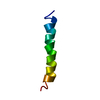
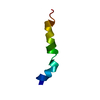
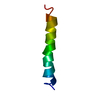
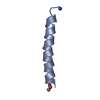
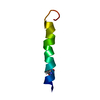
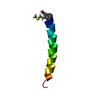
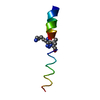
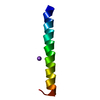
 PDBj
PDBj









